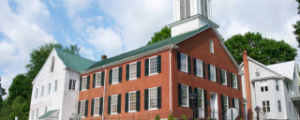Congregations share stories of success
 “It has been a wonderful blessing to our church.”
“It has been a wonderful blessing to our church.”
This is how Bruce Gillette, co-pastor of Limestone Presbyterian Church described the 180 panel, 36 kW solar system his congregation had installed in 2008. Bruce joined a webinar with members of other congregations from around the country who have gone solar as well earlier this month. Put on by the Presbyterian Mission Agency, the webinar provided an opportunity to learn the steps several churches took to go solar.
The Presbyterian Mission Agency is part of the Presbyterian Church U.S.A. and works to connect the church’s 10,000+ congregations on a variety of issues important to the church. This particular webinar was hosted by the Agency’s environmental ministry.
“A lot of churches are interested in solar, and a lot can’t afford it,” said Rebecca Barnes, PCUSA associate for environmental ministries. “So we brought together six churches that were able go solar to share best practices.”
While each story was different, there were common themes. One is the issue of ownership. Churches are non-profit organizations, so they are unable to take advantage of the 30% solar tax credit. This means non-profits like churches will often seek out a third party company that has tax appetite and can monetize the tax credit. This improves the financial returns for congregations.
Webinar speakers described several creative ways the congregations were able to raise funding for their projects.
In Shepherdstown, West Virginia, a church worked with its parishioners and the wider community to crowd-fund the installation. They did so by having demand response controllers installed on their home’s water heating systems. These controllers save about $100 per year. This money is then paid into the project. WV SUN, a program of Community Power Network, helped the community develop the project.
The Flagstaff Federated Community Church wanted to go solar but needed a $40,000 down payment to make the financial math work. It raised that money from church members and others by selling panels in $250 increments. Each purchaser also got an aluminum tag attached. This tag was attached to the bottom of the panel they purchased. Each tag has custom message from its purchaser written on it. So, church members have created a time capsule to be opened to read when the panels come down at the end of their lifespan.
The speakers’ appreciation for the solar systems they installed goes beyond its financial benefits. The process of going solar engaged church members to become active participants in a project they cared about.
Participants also discussed how the systems have become a focal point for the church community. Their visibility also brought in new members who liked the work the congregation did to care for the earth.
To help congregations that are interested in going solar, the environmental ministry has developed a brochure to guide them through the process. You can find additional resources here.
Click here to listen to a recording of the webinar.
